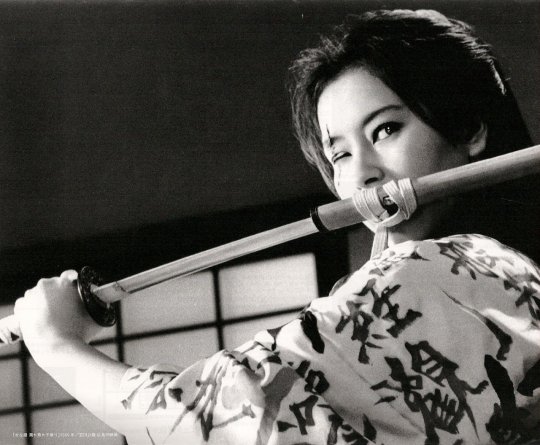#Lady Sazen
Photo

Poster for the 1969 film Lady Sazen and the Drenched Swallow Sword from Daiei Film. Michiyo Okusu stars as a female version of Tange Sazen, the irascible one-eyed, one-armed ronin. Her character is named O-kin, but other than that she’s Tange Sazen through and through.
Genre fans might recognize the samurai in the background: that’s actor Kojiro Hong, a Daiei mainstay who starred in more than a few jidaigeki (samurai) films in his time, as well as a few Gamera films.
#Lady Sazen and the Drenched Swallow Sword#Tange Sazen#O-kin#Michiiyo Okusu#Kojiro Hongo#jidaigeki#chambara
5 notes
·
View notes
Text
mad that i cant find a healthy torrent for any of the old Sazen movies. I wasn't expecting to find all of them or anything, certainly not the old 1920s silent films, but I figured the 1970s series with Ogata or Wakayama, or the last Lady Sazen film would be out there some place. I couldn't even find that remake of the 1Million Ryo Pot that they made back in 2004. I don't have the money right now to be hunting down troves of old ass DVDs on online marketplaces
0 notes
Photo
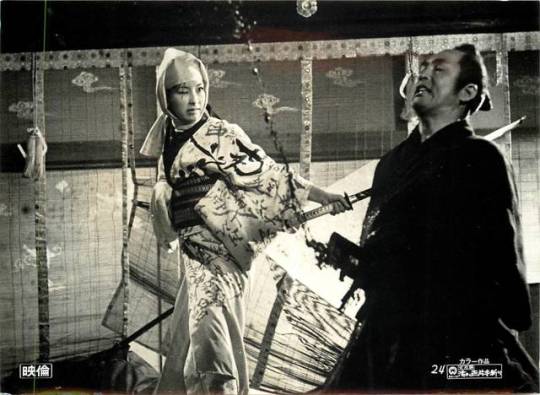
Lobby card for Lady Sazen And The Drenched Swallow Sword (Onna Sazen Nuretsubame Katategiri, 女左膳 濡れ燕片手斬り), 1969, directed by Kimiyoshi Yasuda (安田公義) and starring Michiyo Okusu (大楠道代).
#Michiyo Okusu#Kimiyoshi Yasuda#Lady Sazen And The Drenched Swallow Sword#Onna Sazen Nuretsubame Katategiri#女左膳 濡れ燕片手斬り#安田公義#大楠道代#Daiei#lobby card
48 notes
·
View notes
Text
CARNIVAL DAY recaps [7/13]
Today’s recap: The first few of many ‘character testimonies’, the obligatory Kodansha Editor Characters, and Dokuson’s confession.
[tw: suicide]
--
[BOOK V—CARNIVAL EVE]
--
FORTY
10 May 1997 — 16 May 1997
THE POLES
--
(And in the latest news report…)
On May 10th, satellite pictures show that a cylindrical hole 800 meters in diameter and 350 meters in depth has suddenly shown up at the South Pole, while a mass of frozen earth of that same shape and size has appeared at the North Pole, as if it was teleported. The Billion Killer’s skull is found in the frozen mass.
--
(Diana Hosey is the daughter of Theodore Hosey, the serial killer known as Deep Cut. After her father fled jail, she helped investigate his escape, and after many strange events was invited to the Sanctuary by RISE.
Below is Diana Hosey’s testimony.)
Diana didn’t expect to see her father under the mask of Yellow Bishop. He said he’d been living as RISE’s Dog for decades, their inn’s name Two-Headed Dog now sounding quite ironic. He was eventually chosen to become one of the Rainbow Sophists. While the rainbow had seven colors, there could be less than seven Sophists appointed at a time—though technically there were seven of them right now, as he and Tanna Sazen doubled as Yellow Bishop.
According to Theodore, a necessary requirement to be chosen as one of the Sophists was the ability to look and act like one of the S-detectives when masked. They also needed to be able to act out the corresponding S-detective’s reasoning method. Fabian as a lover of a cartel boss knew well how to use a fake identity to her advantage, sort of like Meiru. Tanna Sazen gathered information on Ajiro’s behavior through Maimu and was himself able to “intensely focus” as a bank clerk. Pacha Palermo just like Frau D could process large amounts of data at a time, although she was an interpreter of many languages rather than a statistician. Aleksandr Uryakov had a similarly mysterious and supernatural reasoning method as Zerofini Roi’s Zero Reasoning. Theodore Hosey personally knew Ronely Queen and used similar logical thinking.
Theodore talked about how his “world chaos theory” pertained to the Crime Olympics. (Diana doesn’t really understand the theory, but she knows it’s a bit like meteorology—forecasting future events from seemingly chaotic data). He said that the case Ronely Queen had solved at their inn had been just a test to see if she could pose a threat in the future. RISE decided that her determination could hurt their cause and so she had to disappear.
Ronely Queen and Ushiwaka Gigolo both died in the Statue of Liberty case while covering Diana. Then Diana and Kakuusan Kanke gathered (intentionally provided) clues about Theodore and went to the Earth House, from where Diana was taken to the Sanctuary. Everything according to the plan. Just like the world chaos theory predicted.
Diana felt furious and sad that her father would manipulate her and lead to her friends’ death. Theodore assured her that Ronely Queen had to die; if she survived, RISE’s plan would be eventually stopped, and as a result the Cosmic Bomb would destroy humanity.
The Cosmic Bomb in question can be also called “shinrui” (“God’s tear”) or a more straightforward name Lunatic Bomb, which makes it easy to guess what it really is.
At the end of the Crime Olympics, the Comic Bomb—the Earth’s own Moon—would fall and destroy the human race.
--
FORTY-ONE
17 May 1997 — 23 May 1997
CARNIVAL IN RIO
--
(Kirika Mai knew nothing about her origins. The strong desire to find her family made her a detective. Not given love, she was instead gifted with insight and logic. Many times she attempted to eliminate that uncertain and inexplicable being that was herself, but was saved by her desire to learn the truth before death; she feared that if she died without knowing anything about herself, her entire life would be worthless in hindsight. Giving up on eliminating herself caused her elimination reasoning method to blossom instead.
The only place that ever felt like home to her was JDC, but then it exploded, leaving her gravely injured. Her life partner Hazama Kuroo died in the Three Monkeys Case. JDC was taken over by a suspicious man called Yuiga Dokuson, and Kirika spent a lot of time investigating him, even visiting his parents in Hiroshima. They seemed like perfectly normal people and didn’t know much about their son’s life after he had graduated high-school. “He was born with a bitter smile,” they just said. Kirika tried to contact Dokuson’s school colleagues, but no one knew a lot about him either, though a lot of tales about his youth still circulated.
Below is Kirika Mai’s testimony.)
Whenever Kirika spoke to someone who knew Dokuson, including his own parents, it seemed to her like all those people were afraid of him, felt uneasy when talking about him, and generally preferred to regard him from afar. Perhaps that rumor about how Dokuson had talked someone into suicide in high-school had some basis. Kirika got the feeling that maybe it wasn’t just people’s fear that hindered the investigation, but that Dokuson had taken measures to hide his past.
Before Ushiwaka left for North America, she warned Kirika against digging too deep. Now that Ushiwaka died and Hyouma was missing, there was no one left who could tell her more about Dokuson—perhaps it was him who quietly eliminated uncomfortable witnesses.
Dokuson was simply too suspicious to ignore. People at JDC told stories about a woman in black (a secret lover? a ninja? a ghost?) who was sometimes heard talking with him in the office, but not many have seen her. Rumors claimed that it was the new detective using the D-name Manji Tawawa, who was about as self-conceited and devilishly beautiful as Dokuson, wore rich pink dresses, and had a bunch of jewelry all in the shape of her D-name. [Manji is written 卍, which is not exactly That symbol, but it’s still about as subtle as a sledgehammer, which is probably why everyone in JDC is calling her Lady Hitler]. JDC quickly split into two cliques based on which local narcissist they preferred, and some wanted Tawawa to become the new representative.
While investigating Tawawa, Kirika found a private detective called Tanegashima Cafe. Her reasoning method was called “happou vision”, happou refering to both “all directions” and “shooting”, as she was firing all her ideas in rapid succession. Tanegashima Cafe had apparently been working together with Kirika when they were both private detectives (which Kirika couldn’t quite remember, as the JDC explosion left her with partial memory loss). She had two young children and often took them to Kyoto’s park Tsukigime, a popular spot for parents and kids. When hanging around there, Kirika was surprised to meet families of JDC detectives.
There was Mizuno Reito (father of Christmas Mizuno), who took care of the household while his wife Chiyoko worked, and often went to the park with his young daughter JDC [yes, that is her first name]. In a funny coincidence, “Chiyoko” and “Reito” together sounded like “chocolate”, and they were born on respectively February 14th and March 14th, which together earned them the nicknames “Valentine Mizuno” and “White Day Mizuno”. [So basically, we have the family of Valentine, White Day, Pyramid, Christmas, and JDC Mizuno. Dear God.]
Another family group in the park were Shiranui Zenzou’s daughter and granddaughter, named Zenzouko and Zenzounene [effectively “Zenzou-kid” and “Zenzou-kid-kid”]. They were given these names to respect the dying wish of Shiranui’s father Taizen to pass his name on in some form. Both also inherited reasoning methods somewhat similar to Zenzou’s own.
Kirika learned about a very lively detective “lady network” made of all those women who constantly sit and talk in parks and always seem to know everything. It turned out they even knew about Tawawa and Dokuson, and told Kirika a bit more. Dokuson apparently was getting his secret info through the ninja detective Sarutobi Shinobu, while Tawawa would buy data from Tanegashima. It was their ability to gather secret data that made them seem geniuses of reasoning.
Realizing that the “lady network” really knew everything, Kirika asked about herself—and finally got the answer.
But now that she solved the mystery of her life, the pressure to eliminate herself returned.
[...and at the end of this testimony that turns out to have been a letter all along, for no obvious reasons there are a few mentions of “Georgia” at the end.]
--
(And in the latest news report…)
On May 17th, during an important soccer match in Maracanã Stadium in Rio de Janeiro, the ball suddenly explodes. No one is hurt, but the match is suspended, agitating the fans and causing an outburst of hooliganism that kills close to a hundred people. The Billion Killer's skull is found in a ditch by the sports grounds.
Earlier that year, an incident of mass suicide took place during the Carnival in Rio de Janeiro. Investigation found a worldwide suicide cult calling themselves Carnival Dice (or just DICE). It has been confirmed that JDC's Kirika Mai, who disappeared leaving only a suicide note, had been in contact with DICE. JDC announced they would search for Kirika and attempt to stop the cult.
--
FORTY-TWO
24 May 1997 — 30 May 1997
AYERS ROCK
--
XX would never guess he’d become a JDC detective so quickly, but it wasn’t that hard with the entrance exam abolished. XX’s job interview was led by a detective nicknamed Cappuccino Knob Suzuki (actually Suzuki Nobuyuki), who had previously worked as a Kodansha editor and even took part in publishing Cosmic and Joker. [Suzuki Nobuyuki is an actual Kodansha employee.]
Ever since the Crime Olympics began, a lot of “description detectives” or “writer detectives” started to pour in, their reasoning based on describing an incident as a book narration. Since every writer needs a good editor, that’s how “editor detective” Suzuki got his new job overseeing MAT (“Mystery Attack Team”). There are also “reader detectives” responsible for careful analysis of the stories.
In the world where new mysteries and incidents constantly surround everyone, more people than usual start to awaken their detective instincts. People have a need to solve mysteries. They also need to make stories; living in itself is writing a story about themselves.
--
(And in the latest news…)
...on May 24th, an earthquake caused Uluru / Ayers Rock in Australia to split, a part of it breaking off and killing a few tourists. The Billion Killer’s skull fell out of the newly made crevice during the earthquake.
...the JDC representative Yuiga Dokuson disappeared on June 6th, incidentally the day of his 27th birthday. In his office he had left a video tape with a confession:
“To tell you the truth, the Billion Killer is me. For various reasons I have been causing all the incidents until now, but there’s no further need for them. The Billion Killer cases end today. Humanity, rejoice.”
--
FORTY-THREE
31 May 1997 — 06 Jun 1997
CRYSTAL MOUNTAIN
--
(Below is Inugami Yasha’s testimony. [Originally in first person.])
If only Yasha had paid more attention to his surroundings, maybe the tragedy wouldn’t have happened. But it’s too late for regrets; the past can’t be undone.
At that time, Sayo was away from Gensoukan. When Yasha went outside to search for Kanaihidetaka, a person put a blade to his neck from behind, drawing blood, and ordered him to stay quiet in a muffled voice. Yasha wasn’t able to tell the stranger’s gender or age from the voice. When Juku opened the door to go outside, the assassin pushed Yasha away and charged, but Juku managed to jump away. The assassin wore silver clothes and a bull mask. Juku asked the enemy if they were Tsukumo Jaki / Yakuma Suzume, but was ignored. The assassin instead leapt at Juku, piercing his chest with a sword and forcing him to the ground.
Something unexpected happened right afterwards. When the assassin raised the sword again to deliver the final blow, they suddenly stopped moving, and Yasha heard their muffled voice saying something like “Godust… Alive… sh…”. The sword fell from their grasp and they collapsed on top of Juku, both the attacker and the victim now completely still on the ground.
Yasha couldn’t move both from shock and from blood loss, but thankfully Sayo returned right at that moment. Yasha heard her yell right before he lost consciousness. When he woke up in a hospital bed, he was told that Sayo had called an ambulance, but the help came too late and Juku passed away.
When the ambulance got to the scene, Sayo, Kanaihidetaka, and even Gensoukan were no longer there and couldn’t be found later, as if they had never existed.
The masked assassin was discovered to be not Yakuma Suzume, but the writer Minase Nagisa (real name Tamei Madoka). She had apparently died of Alive with strangely perfect timing just before she could deliver the final blow.
Yasha realized what Jaki had meant warning them about “sankaku, shikaku, maru”. It didn’t mean “triangle, square, circle”. Sankaku could mean someone taking part in a plan. Shikaku was an assassin. Tamei Madoka’s first name was written 円, this kanji having an alternate reading of maru.
After Juku’s death, Yasha became Dokuson’s helper as JDC’s first vice-representative. This unexpectedly led to him becoming the actual representative after Dokuson left his confession and fled. Leading JDC wasn’t in Yasha’s plans at all, but he decided to help everyone as he could.
[End of testimony.]
--
The writer detective XX stumbles upon files about “the phantom case of the Seppuku Detective”, which was solved by Suzukaze Unomaru.
Once upon a time, a woman wandered into a forest known for suicides and found a house called Gensoukan, where she met two men. One was the seppuku detective, another was a genius surgeon dressed in white. The detective would repeatedly attempt seppuku—the state between life and death sharpening his reasoning—and the surgeon would then piece him back together.
The woman got into a romantic triangle with both men. However, one night the detective actually killed himself in secret, and the other two fell apart and went their own ways away from Gensoukan. When the woman returned to the forest later, the house was no longer there.
The woman asked JDC to help her find the house and the surgeon. The tale was clearly absurd, but Unomaru wanted to check if it had any basis in reality.
The woman indeed had been in a triangle relationship with two brothers, but then the older one (Endou Naoto) disappeared, and the abandoned pair split. The woman attempted to contact the younger brother (Endou Masato) a few years later, but found that he had mysteriously fled. This entire “Gensoukan” must have been just a metaphor for lost love and happiness.
While the case was technically solved, XX thinks there has to be more to it, especially since the recent case of Juku’s murder also involved a disappearing Gensoukan. Additionally, that short story Another Joker was set in Gensoukan, and its alleged author was the brother of the masked assassin.
XX asks Yasha for a testimony about everything that happened [the one we just read]. He learns about “Seiryoin Ryusui” being the suspected “third writer”, about the Yakuma Suzume hypothesis, and about the two Endou brothers. Everything is starting to come together.
--
FORTY-FOUR
07 Jun 1997 — 13 Jun 1997
NUCLEAR WEAPON TEST
--
(And in the news…)
...On May 31st, a giant fire broke out on Mount Roraima in South America and had been raging on for a week. The Billion Killer’s skull was found in an extinguished part of the slope.
...the investigation of Mount Roraima revealed the existence of a group called F4C (Fire 4 Card), also suspected of bombing buildings and setting fires during the Crystal Nightmare. The name comes from the group always leaving four playing cards the size of an adult on the crime scene, always the four different colors of the same number, starting from twos during the Crystal Nightmare, up to aces on Mount Roraima. As the usual skull was found in the Mount Roraima fire, it points to the group’s possible connection with the Billion Killer.
...tensions between India and Pakistan heightened with both countries announcing multiple underground nuclear tests.
--
The writer detective XX decides to try solving the “seppuku detective’s phantom case” by writing about it.
Books about real cases sell unusually well in the new society of the Crime Olympics. Way back in February, Kodansha even sent over their editor called Katsushi Outa to scout for good stories from the writer detectives. [The real Kodansha editor Katsushi Outa just had to appear eventually, didn’t he.] He later became an editor detective with the D-name Strong J Outa.
The (by that time) vice-representative Yasha asked XX and Outa a strange favor: to start writing and publishing more books under the pen name Seiryoin Ryusui, as that would somehow help end the Crime Olympics.
--
[>>>NEXT PART>>>]
3 notes
·
View notes
Text
Aah now I'm curious about Tange Sazen and Lady Snowblood ww
0 notes
Text
nano novel outtake:
The Goldsnare, a prestigious event that only happens every ten years, is one of the greatest draws of the country of Sazen. Two weeks of highly publicized fights between guilds for money from the Crown accompanied by two weeks of festivities for everyone not affiliated with the guilds.
Each of the four guilds — Sorce School, Shadestep, Dawntrace, Knightwatch �� choose eight members to fight each other, tournament elimination style, for the title of Guild Champion. Sorce School’s fights tend to draw the biggest crowds, as fights between trained combat mages are always a delight to watch for all audiences, with Fire and Wind and Earth and all the elements being thrown around by highly practiced individuals. Dawntrace has the second highest attraction. Bounty hunters with varying weapons and skillsets make for fights that lean towards the brutal, effective, and a little underhanded. They’re also a learning experience for many that would think of going into the bounty hunting profession and possibly joining that guild.
The audience for the Knightwatch fights are few, but full of blue blood. As many minor children of nobility enter the ranks of the military to earn prestige for themselves, lords and ladies like to see how the fruits of their funding have contributed to highly trained knight-soldiers. Shadestep, being shady and secretive as assassins are, allow very few to watch their fights, but they make ticket money nonetheless.
Once a Champion is selected, they fight each other in one-on-one matches. Afterwards, they’re ranked by their victories, and monetary awards given to each guild based on their Champion’s ranking.
It’s an honor, to fight for your guild, they say. Becoming champion always means prestige, doors opened. It means people will know you, that they may even feel indebted to you for getting the guild more funding.
Keris wants nothing of it.
She’s the Escape Artist, a thief that steals upon demand of the guild elders. Fame and prestige and recognition are literally the worst things for a thief.
“What are they thinking?” Keris asks herself.
They aren’t thinking of you, of course. Someone says from the recesses of her mind. They never have. I’m the only one that thinks of you-
Her hand slaps up to cover her nonexistent left eye out of habit. “Fuck off, Thorn,” she bites out.
He doesn’t, of course, because he was never there in the first place.
6 notes
·
View notes
Text
Cosi Fan Tutte (1989)
Cosi Fan Tutte (1989)
Officers Ferrando and Guglielmo are certain that their lovers Dorabella and Fiordiligi are faithful to them, but the cynical Don Alfonso challenges them to a bet that the women will be unfaithful given the chance. The officers thus pretend to go off to war, and return in disguise as Albanian strangers, to woo Dorabella and Fiordiligi incognito. The ladies are initially frosty, but soon warm to their new suitors, spurred on by their maid Despina. Performed at the La Scala Theatre in Milan.
Try five more:
Under the Sign of the Bull (1969)
Ski School 2 (1994)
Action (1980)
Murder at Site 3 (1958)
Tange Sazen: Mysterious Sword (1960)
0 notes
Photo


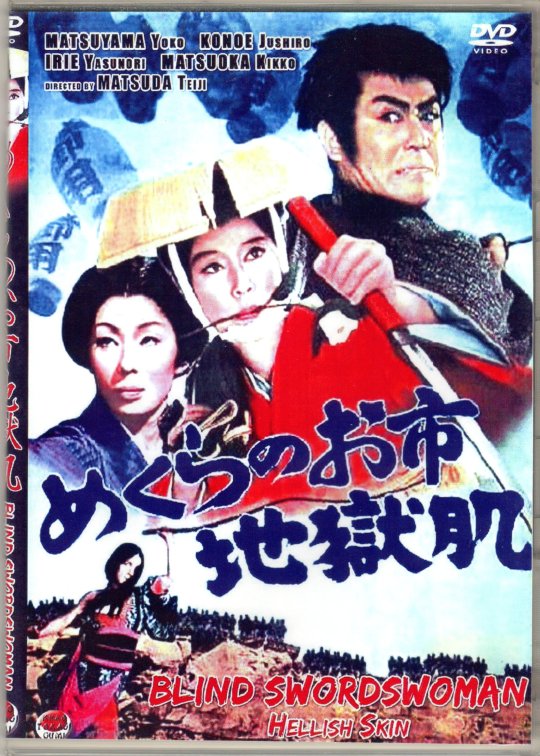
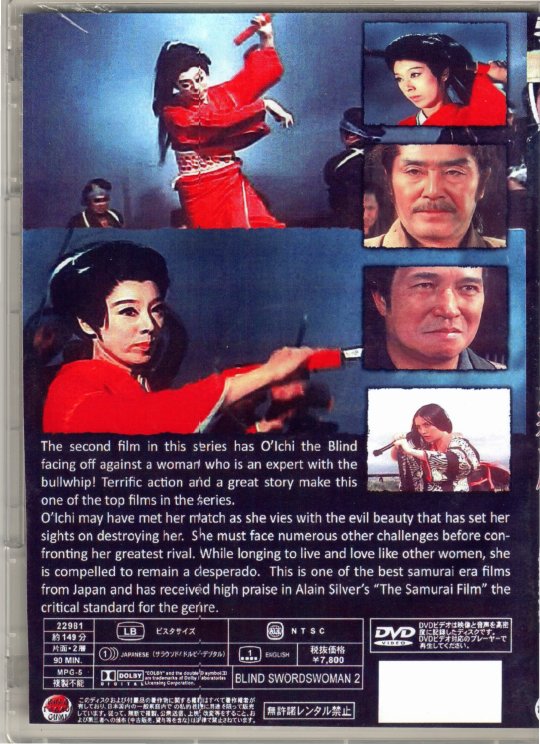
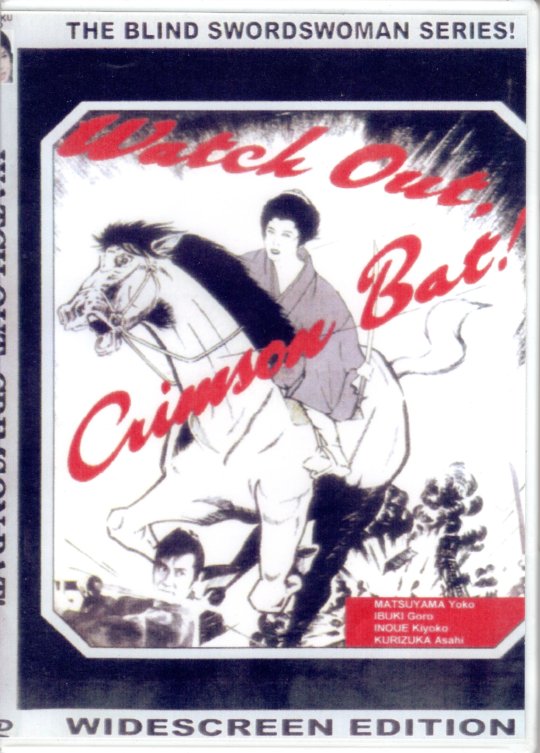

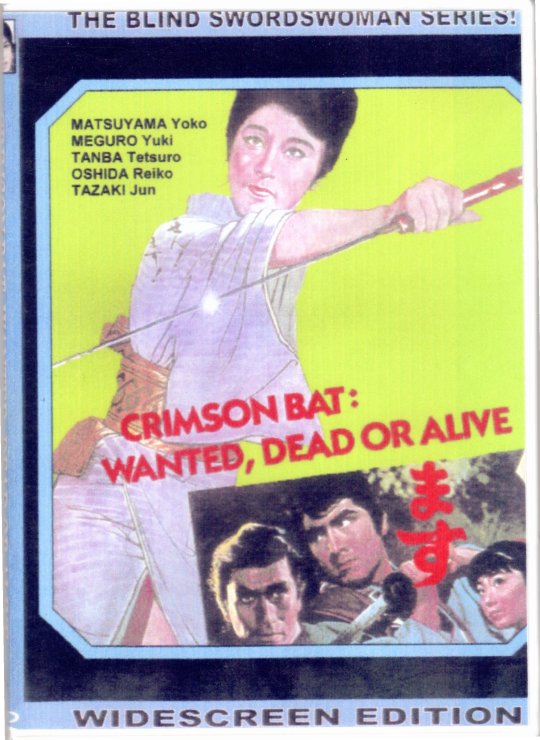
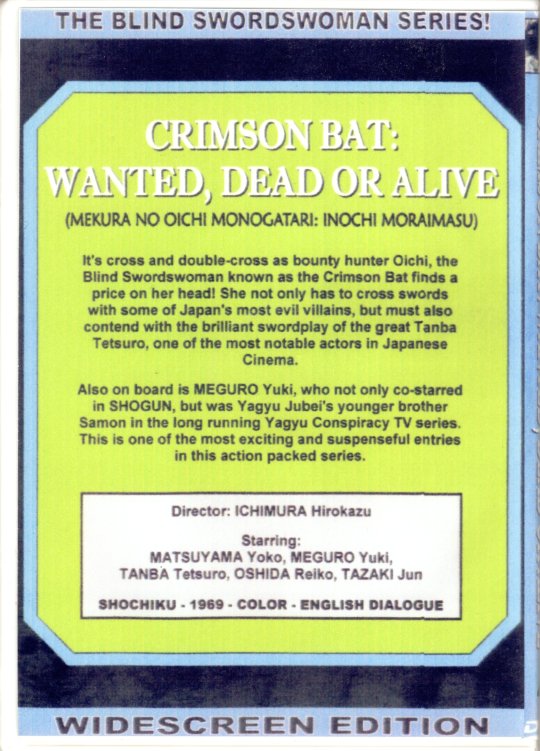
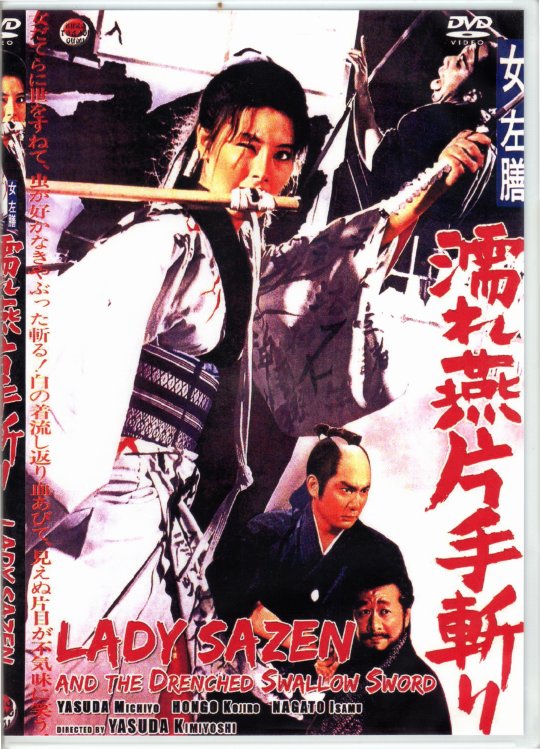
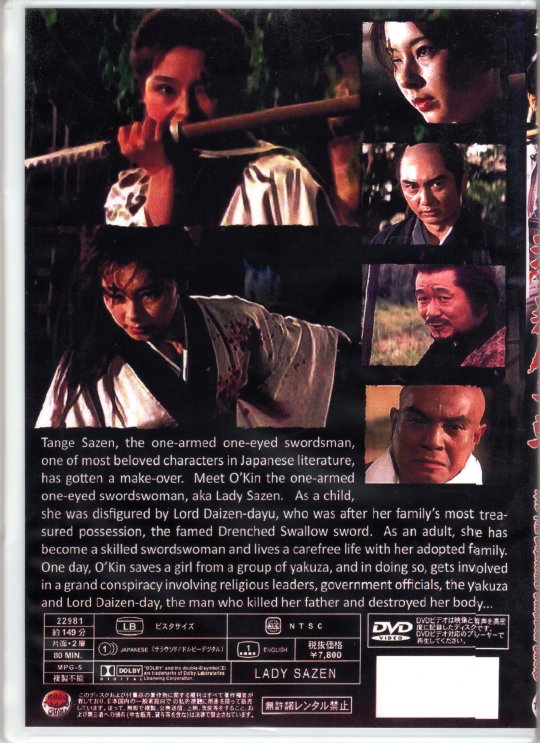
1969 was an interesting year in Japanese cinema, as the public was presented with distaff versions of two extremely popular characters: Zatoichi, the Blind Swordsman, and Tange Sazen.
The first was The Crimson Bat series from Shochiku Studios. The series stars Yoko Matsuyama as Oichi (referered to several times in the series, even by herself, as “blind Oichi” or “Oichi the blind”). Strangely enough, she is never called Crimson Bat in any of the films, and that name only appears on the international versions of the films. There is much speculation as to where the name came from, although Oichi does carry a red sword cane, and her costume through most of the second of the second film is a red kimono.
While based on a manga series, the films are clearly a response to the popularity the Shinato Katsu Zatoichi film series, produced by Daiei and still running strong at the time.
Other than the obvious difference between the characters in that Oichi is female, she is also given the rather sexist weakness for always pining for love, and usually falling for one of her male adversaries. While that might make sense in the first film before she becomes an expert swordswoman and learned to be self-reliant, it makes absolutely no sense in the later films when she’s become a bounty hunter.
Another big difference between the two: Zatoichi is always portrayed as scruffy and looks like he’s spent most of his life living on the road. Shintaro Katsu was also kind of pudgy, and certainly - at this point in his career - could not be accused of having matinee idol looks. Oichi, on the other hand, is just flat out gorgeous. Her make-up and, clothing and hair always look like she’s ready for a modeling gig. And she has the super-power of always keeping her hair perfectly coiffed, either while battling dozens of opponents or falling off cliffs (which she does a couple of times),
There were only 4 films in the series, the first 3 released in 1969 and the last in 1970. The following year Yoko Matsuyama returned to the role in a TV series that ran for 25 episodes. Ms. Matsuyama also went on to marry Teruo Tanashita, the artist who created the original manga introducing Oichi, the lucky guy. In America I guess the equivalent would be William Moulton Marston or Harry G. Peter (the creators of Wonder Woman) marrying Linda Carter.
I enjoyed the movies despite the annoying flaw with Oichi’s character, but I guess the filmmakers thought it was necessary A: because she was a woman (that’s just my assumption; I don’t agree with that as a valid reason); or B) to differentiate her more from Zatoichi.
I haven’t been able to locate the TV series yet, but would love to check it out if I do.
The second distaff character making the scene in 1969 was Lady Sazen, the female version of Tange Sazen.
Tange Sazen is a one-armed, one-eyed ronin who was introduced in 1927 as a minor character in a serial story about Ooka Tadasuke, an actual historical person who was a magistrate in Eo (Tokyo) during the Shogunate. Tange Sazen was so popular with the readers, however, that three films were produced by three different studios featuring Sazen as the hero. These were so successful that a new story, with Sazen as the hero, was serialized in the newspapers.
Tange Sazen went on to have a long career in both print, film, and eventually TV. There were several film series, sometimes from competing studios released in the same years, released in Japan, The character has been portrayed by several notable Japanese actors. The ones most familiar to most Western fans who be Ryutaro Otomo (Orochimaru from The Magic Serpent), Kiinosuke Nakamura (Itoo Ogami in the Lone Wolf and Cub TV series), and Tetsuro Tanba (Tiger Tanaka in You Only Live Twice, and one of Japan’s most prolific actors - the man never turned down a role!).
The character is so popular because, like Zatoichi, he is considered an outsider from society due to his handicap, but is nonetheless a tireless champion of justice and the downtrodden.
Lady Sazen and the Drenched Swallow Sword from Daiei Film stars Michiyo Okusu (billed as Michiyo Yasuda), who - despite the fake scar over her right eye - is almost too pretty to be taken seriously in the role. Her character’s real name is O-kin, but people call her “Lady Sazen” because of her similarity with Tange Sazen (which, to digress, is kind of meta: in the world of this film does Tange Sazen actually exist, or is he a fictional character that O-Kin resembles?).
Like her male counterpart, O-Kin loses her arm and eye due to treachery. She trains herself to become a master swordswoman, and is quick to butt in when she finds injustice. The main plot of the film involves a daimyo (feudal lord) who is a rabid sword collector trying to get O-Kin’s fabled Drenched Swallow sword for himself. It turns out the lord is also the one responsible for O-Kin’s disfigurement and the death of her family when she was younger.
Ms. Okusu/Yasuda does a wonderful job with what is traditionally a male role. Despite her beauty, she does her best to scowl menacingly, talk gruffly, and be prickly in the best Tange Sazen fashion. She did a great job at Sazen’s signature move, which is drawing her sword while holding the scabbard in her teeth. She does well in the sword fighting scenes, especially with the difficulty of having to do so with her right arm tucked behind her back.
This was not the first time a female version of the character had appeared on the silver screen. Thirty years earlier Komoka Hara gave audiences a Lady Sazen in at least one, some sources say maybe two film. The main difference there, at least as far as I can ascertain, is Ms. Hara played Tange Sazen as a female character, instead of Ms. Okusu/Yasuda’s playing a woman who is similar to Sazen, but isn’t actually Tange Sazen.
The film’s co-star is Kojiro Hongo, who was one of Daiei’s matinee idols, and many fans may recognize him from a few of the Showa-era Gamera films. There’s also the usual stable of supporting actors you’ll find in every Daiei film from that period, many who had appeared in all the Zatoichi films.
Sadly, there was no follow-up to this film. I don’t know whether it was because the film did poorly at the box office, or because the audience did not accept a female Sazen.
Or maybe it fell victim to Daei’s impending collapse. The advent and popularity of television was killing off the film industry in Japan at that time. By the early 1970s the studio system as it was known in Japan had disappeared, studio and film budgets were drastically slashed, and Daiei was bankrupt and out of business.
Nevertheless, this was another film I enjoyed. It actually shares a spot on my DVD shelves with my other Tange Sazen films, whereas all others I meticulously store in alphabetical order.
5 notes
·
View notes
Text
TANGE SAZEN
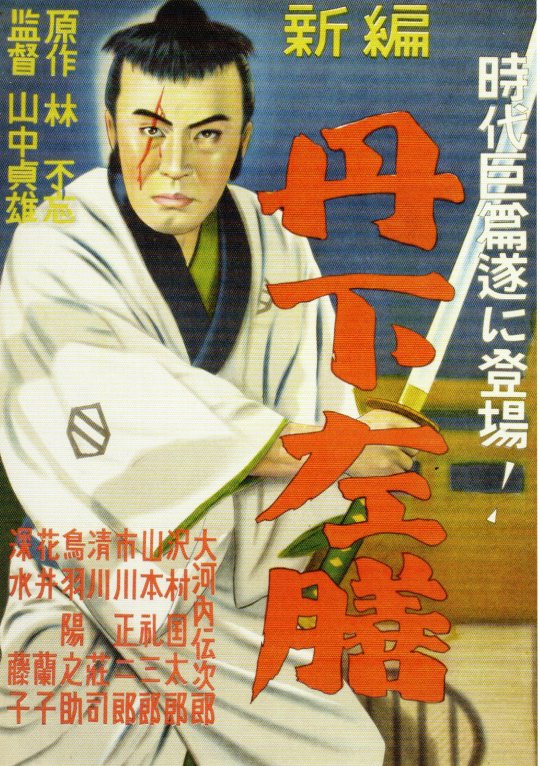
poster for the 1935 film Tange Sazen Returns, starring Denjiro Okochi. For some unknown reason, his right arm seems to have grown back!
Tange Saßen, the irascible, one-eyed, one-armed ronin with a strong sense of justice, is a popular character in Japanese film, television, and novels,

DVD cover for the 1935 version of Tange Sazan and the Pot Worth One Million Ryo, starring Denjiro Okochi
Tange Sazen was originally just a minor character in a serialized story published in 1927 about a Ooka Echizen, an historical figure who was a magistrate in Edo during the Tokugawa Shogunate. However, Sazen’s dramatic appearance, especially as rendered in drawings accompanying the serialized story, really caught the public’s attention.

DVD cover for the 1982 television movie version of Tange Sazen and the Pot Worth One Million Ryo, starring Nakadai Tatsuya
Film studios picked up on Tange Sazen’s popularity and, a few months after his initial appearance, three different studios released Tange Sazen films. The most popular of the three starred Denjiro Okochi, who is the actor most associated with the role. Okochi-san eventually made 13 Tange Sazen films.
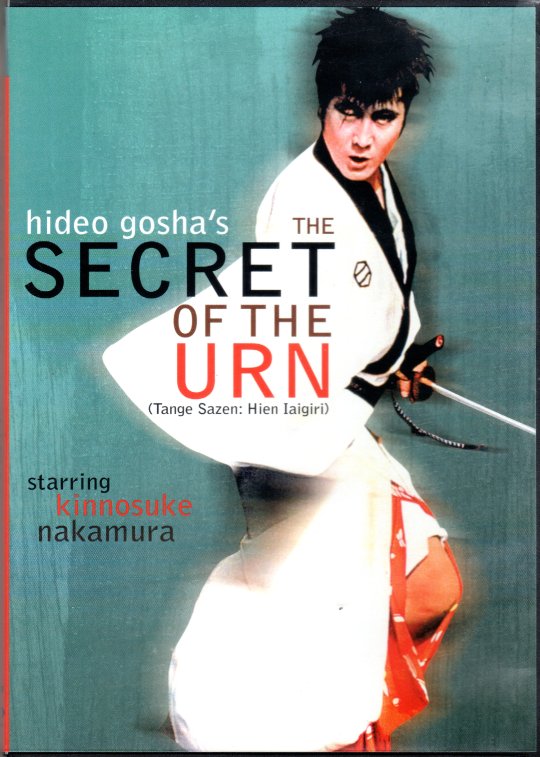
DVD cover for The Secret of the Urn, the 1966 version of Tange Sazen and the Pot Worth One Million Ryo, staring Kinnosuke Nakamura and directed by the great Hideo Gosha
Tange Sazen’s creator, Fubo Hayashi, was so impressed by the success of the films that he wrote a new serial, this time with Tange Sazen as the main character. This serial evolved Sazan’s personality from the nihilist he was originally, to the cranky, argumentative, righter of wrongs that the public loved so well.

DVD cover for Tange Sazen, the 1958 version of Tange Sazen and the Pot Worth One Million Ryo, starring Ryutaro Otomo
The serial, Tange Sazen, was made into the 1935 film Tange Sazen and the Pot Worth One Million Ryo, again starring Denchiro Okochi. This time Okochi-san gave Sazen a more comic side, which again was very popular with theatergoers.
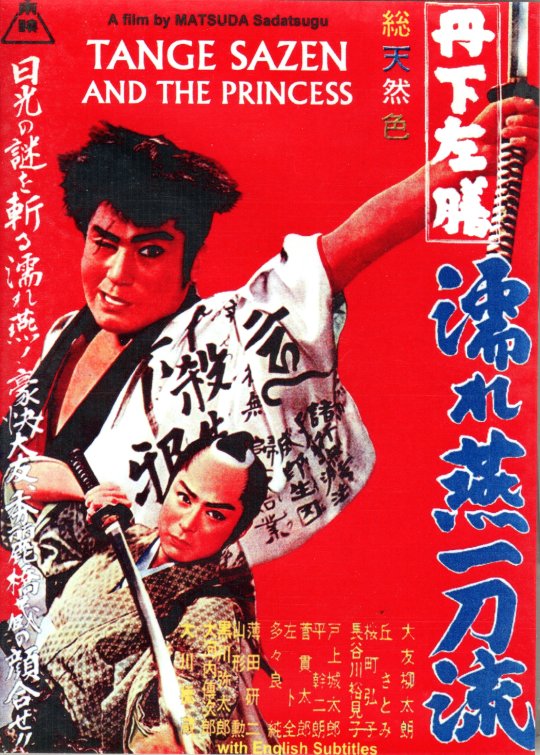
DVD cover for Tange Sazen and the Princess, a 1961 film with Ryutaro Otomo again playing Sazen
I don’t know if Fubo Hayashi wrote any other Tange Sazen novels, and I would appreciate any information any one might have. However, Tange Sazen has been filmed (as Tange Sazan and the Pot Worth One Million Ryo, or similar titles) numerous times, with each actor who portrays Sazen getting a crack at the story.
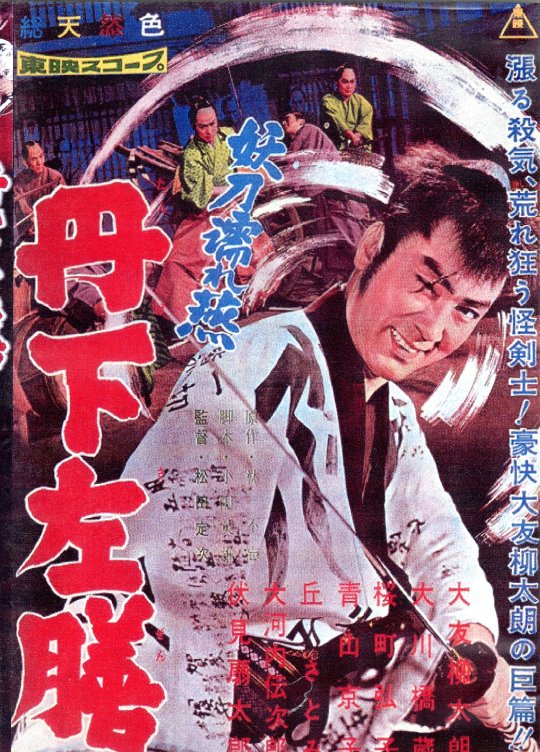
DVD cover for 1960′s Tange Sazen: The Mysterious Sword, again with Ryutaro Otomo as Sazen
Besides Denjro Okochi and his 13 films as Tange Sazen, the next film actor most associated with the role is Ryutaro Otomo. Otomo-san was a popular star of jidaigeki (samurai) films in the 1950s and 60s. He first played Sazen in 1958, and then returned to the role at least 4 more times (I have found conflicting data on the Interwebs, but I know he made at least 5 films as Tange Sazen).

DVD cover for The 1959 film Tange Sazen: The Mystery of the Twin Dragons (no, not the Jackie Chan film!); Rytaro Otomo returns again as Tange Sazen
In addition to the numerous Tange Sazen films (of which there are supposedly 34, but I have not yet been able to find a comprehensive list), there were at least 3 television series about our hero. The first ran from 1958 to 1959, and starred Tetsuro Tamba, aka the hardest working man in Japanese cinema (it is said that he never turned down a role, no matter how outrageous).

DVD cover for the 1963 version of Tange Sazen and the Pot Worth One Million Ryo, The One-Eyed Swordsman, starring Tetsuro Tamba as Tange Sazen
Tamba-san returned to the role in 1963 for The One-Eyed Swordsman: Tange Sazen, which another adaptation of Tange Sazen and the Pot Worth One Million Ryo. What’s unusual about Tamba-san’s performance is that his Sazen is missing his left arm and is blind in the left eye, while the character has always been described/depicted as missing the right arm and blind in the right eye. I don’t know if Tamba-san played the character that way in the television series, as I have not been able to track down an episode, nor do I know if the film is in any way related to the series other than having the same main character.
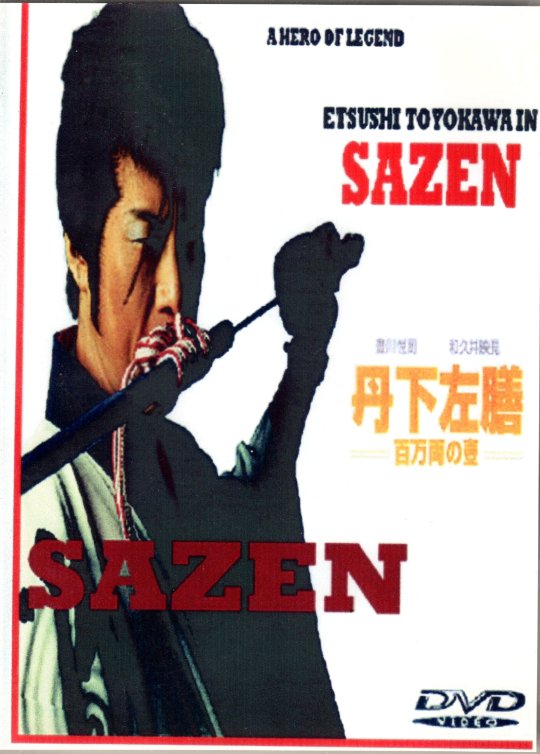
DVD cover for Tange Sazen, the 2004 film version of Tange Sazen and the Pot Worth One Million Ryu, starring Etsushi Toyokawa
Other famous actors (at least here in the West) who’ve portrayed Tange Sazen in film and TV are Akira Kurosawa favorite Tatsuya Nakadai (Sanjuro, Ran), and samurai film veteran Kinnosuke Nakamura (also known for playing Ogami Itto in the Lone Wolf and Cub television series).
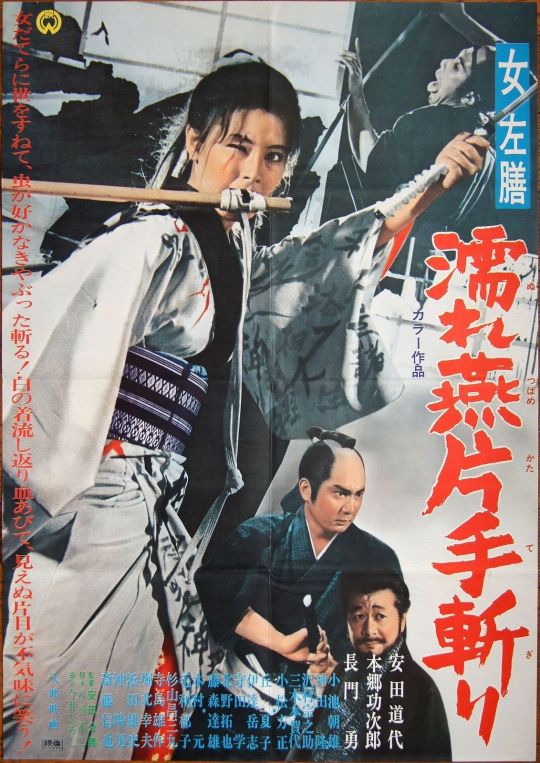
poster for Lady Sazen and the Drenched Swallow Sword, a 1969 film starring Michiyo Yasuda
There were also at least two female versions of Tange Sazen!
Actress Komako Hara played a female Tange Sazen in a pair of films from the late 1930s. I have not seen these, and don’t know if they’re considered lost like so many pre-World War Two Japanese films are.
Then there’s 1969′s Lady Sazen and the Drenched Swallow Sword. This one stars the pretty Michiyo Yasuda as O-Kin, a female swordswoman who is not Tange Sazen, but disfigured exactly like him, and has the same cantankerous demeanor, but is ready right any wrong no matter the cost. As you can see from the poster above, she has mastered Sazen’s signature move of drawing her katana one-handed by holding the scabbard in her teeth.
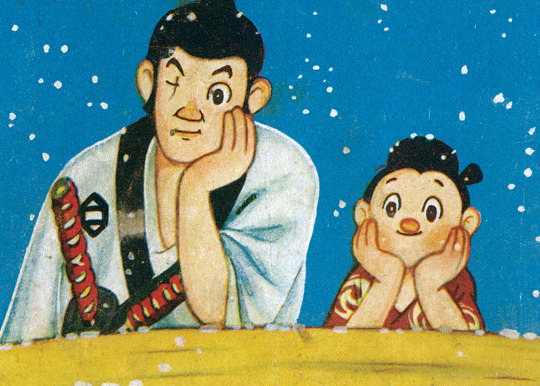
cover to Osamu Tezuka’s 1954 Tange Sazen manga
Then we have the 1954 manga Tange Sazen, by the king of manga himself, Osamu Tezuka. This is an adaptation of the original Tange Sazen serial, so it’s really just the manga form of Tange Sazen and the Pot Worth One Million Ryo. I’ve not read it yet, although I did find a Japanese copy for sale on Amazon. I’ll have to check the Internet Archive to see if anyone uploaded a translated version.
So there you have it: my crash course introduction to Tange Sazen. I hoped this piqued your interest, and you seek out the films to discover this wonderful character for yourself.
#Tange Sazen#Tange Sazen and the Pot Worth One Million Ryu#Tange Sazen Returns#The Secret of the Urn#Tange Sazen and the Princess#Tange Sazen: The Mysterious Sword#Tange Sazen: The Mystery of the Twin Dragons#Lady Sazen and the Drenched Swallow Sword#Denchiro Okochi#Ryutaro#Otomo#Tetsuro Tamba#Tatsuya Nakadai#Kinnosuke Nakamura#Michiyo Yasuda#Osamu Tezuka#jidaigeki#manga
18 notes
·
View notes
Photo

Poster for Lady Sazen and the Drenched Swallow Sword (Onna Sazen Nuretsubame Katategiri, 女左膳 濡れ燕片手斬り), 1969, directed by Kimiyoshi Yasuda (安田公義) and starring Michiyo Okusu (大楠道代).
#Michiyo Okusu#Kimiyoshi Yasuda#Daiei#Lady Sazen and the Drenched Swallow Sword#Onna Sazen Nuretsubame Katategiri#女左膳 濡れ燕片手斬り#安田公義#大楠道代#poster
14 notes
·
View notes
Text

Guilty Gear has always been a series just dripping with style thanks to the wildly varied talents and tastes of Ishiwatari Daisuke. But in the sizable cast of rock’n’roll and heavy metal inspired fighters, one of my all time favorite designs has been the dramatic redesign of Baiken in Guilty Gear Xrd. Let me break down why!
So starting with her design in general, the origin story goes that Ishiwatari Daisuku saw an illustration of Himura Kenshin, from the manga Rurouni Kenshin, and liking the design, but mistaking Kenshin for a woman, based Baiken’s early art off of that. Her earliest art seems pretty in line with that, right down to the red hair, but notably that hair changed colors, shifting towards more of a deep pink. Her name, Baiken [梅喧] is written with the kanji meaning “Plum” and ”Noisy/Uproarious.”

Like many flowering plants, the word can refer directly to either the fruit, the tree, or the flower; and many common girls names in Japanese use the names of flower. The name Baiken thus reads as a kind of self descriptor, communicating the idea of a “Loud & rambunctious woman.” The plum blossom is also where her hair color and various emblazoned clothing designs come from.
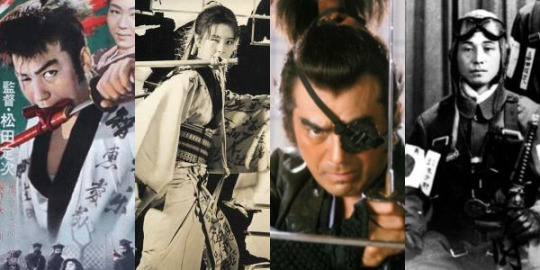
Her one-eyed, one-armed swordswoman gimmick is also a direct reference to a number of sources. Initially the overt reference in her design is to the character Tange Sazen, a character from a series of films from the 30s, 50s, and 60s. (themselves, spinoffs of a serial novel from the 20s.) But there have also been three Lady Sazen films, further spinoffs depicting a genderbent version of the iconic character.
In her updated Xrd design, she covers her scarred eye with a curious kind of accessory: a katana crossguard (tsuba) under the lens of a single-eyed aviator goggle. The eyepatch is a reference to another famous swordsman character, Yagyuu Juubei. Unlike Sazen, Juubei was in fact a real historical figure, although much of his reputation is built upon folk lore or pure fiction. Juubei has become a name synonymous with eyepatch wearing swordsmen (sometimes samurai, sometimes ninja), whether they are meant to be the legendary character himself, or simply named after him. And the distinctive tsuba eyepatch is derived from his portrayal by martial arts actor Sonny Chiba in various chanbara films and TV shows from the 70s and 80s.
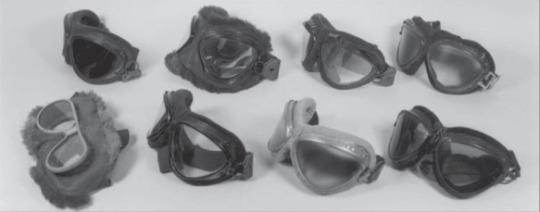
The aviator goggles are a bit more obtuse, in part because they aren’t entirely accurate, but the flight goggles (as well as the combat boots) are evocative of Japan’s kamikaze pilots. The small issue is that the WWII model goggles were larger and rounder, where as the particular flat angled lens are more distinctive of the British RAF. The combat boots, also evoking a bit of a soldier aesthetic, are cut into sandals in the style of a samurai’s suneate and waraji.
But of course the most noticeable addition to her wardrobe is the school uniform she wears over her shoulders like a half-cape. The school uniform itself is an older, and nowdays lesser used, style called a gakuran; once a fairly ubiquitous style, in modern Japan it’s relegated to middle schoolers, rather than high schoolers. The particular open style of it however is derived from equally outdated Yankii and Banchou aesthetics: a kind of high school delinquent archetype that was popular in manga and even film in the 70s and 80s. Of note here is that she still leans on the Banchou look with the boys’ uniform, and not something from the image of the Sukeban (the girl gang archetype of the same era) lending her a bit of an androgynous vibe. (one somewhat unfortunately offset by her enormous breasts.)

She’s also sporting a fun skull design that is a pretty obvious attempt at a legally distinct spin on the Misfits logo. It’s a nice way to compliment the delinquent theme while also tying her to the Punk genre. Most of the Guilty Gear cast are themed around various rock bands and musicians, but Baiken has always been one of just a handful that are curiously non-musically themed. Kind of a shame they don’t throw more of the Horror Punk aesthetic in there, though.
Additionally, while she wears a pretty normal looking kimono and kind of silly sarashi (the body wrap that confusingly ISN’T binding her gigantic breasts into place), her belt and makeshift half-cape are tied with a kind of braided and tasseled cord called a Fusa-himo. A Fusa-himo is generally not an article of clothing; it can be used in decoration and for binding a sword sheathe, but as clothing it’s generally considered a synonym for a western aiguillette, used in military uniforms. I can’t really tell if its more evocative of a soldier or of a katana decoration in the way it’s used here.
And speaking of accessories, just a handful of other little samurai goodies that really give her character some flavor and texture:
Samurai strut: a distinctive chin up(looking down on others), chest out swagger originating in the character acting of Kabuki theater, but taken more directly from the body language of actors on film in classic chanbara film.
Tatami-Gaeshi: “Mat block.” A film cliche of samurai and ninja fiction where an ambushed warrior upturns a tatami mat from the floor of the room he’s in to defend himself.
Nuguigami: Wiping paper used in traditional sword cleaning (which she of course has to used with her mouth, mixed with the Falling Paper/Leaves/Silk cutting cliche from samurai fiction.
Kiseru: The traditional Japanese tobacco pipe with metal bowl and mouthpiece. The Kabuki-mono (a sub-culture of gaudy, rowdy, and generally socially disruptive samurai in the 1500-1600s) were known to carry large Kiseru as one of their many ways of showing off, but given how prone to bar brawls they were, it was said some were so large (and considering their metal components) they could be used to fend off attacks from a sword.
Hyoutan: The hollowed Calabash gourd used to store sake.
Manriki & Tekko-kagi: The weighted chain weapon and hand claw she keeps concealed in her empty sleeve.
Kanabou: In her Xrd design, the simple metal claw was changed into an iron club with retractable clawed joints.
O-zutsu & Taihou: Her lacquered handcannon and full size cannon that she pulls out of her loose sleeve.
The fullsized cannon is decorated with a Shisa head: an Okinawan guard dog statue, related to the Chinese lion-dogs, but identifiable by its distinctive tightly curled mane pattern.
123 notes
·
View notes
Text
CARNIVAL DAY recaps [12/13]
Today’s recap: Explanations and more explanations, or: confronting Tsukumo Jaki, the tale of two brothers (ft. very important underwear), Seiryoin’s true identity, and wordplay upon wordplay upon wordplay.
--
Time passes in the Sanctuary. After Ajiro recovers, he and Hyouma talk a lot about their relations. [Basically they throw compliments at each other and it’s heartwarming.]
Now that Ajiro turned out to be okay, Hyouma wonders if they can save other people considered dead or missing. He makes a list of every important person [which I’m pretty sure is just Seiryoin’s way of reminding us what happened to all these characters].
The dead: Matsuo Tenmei (a JDC employee), Fuyuu Kasumi, Mito Muramasa, John Morse, Suzukaze Unomaru, Drexel Uryakov, Hazuma Kuroo, Sado Kutou, Ryuuguu Jounosuke, Fuumonji Jouka, Tierra, Silva (the old woman), Tsukumo Juku, Desert Colosseum, Ronely Queen, Ushiwaka Gigolo, Firannu Meirunesia, Somedaring Amagoi (probably?), the Dot who looked like Yuu.
The missing: Tousen Yomiko, Yakuma Suzume (the real one), Kirika Mai, Yuiga Dokuson, Sarutobi Shinobu, Manji Tawawa.
The living: Ajiro Souji, Yaiba Somahito, Tsukumo Nemu, Hikimiya Yuuya, Amagi Hyouma, Christmas Mizuno, Kakuusan Kanke, Ryuuguu Otohime, Diana Hosey, Zerofini Roi, Inugami Yasha, BOKU, Hanto Maimu & Kuraimu, Tanna Sazen, Endou Naoto (White), Ryuuou (Black), Joyeeta, Fabian, Pacha Palermo, Theodore Hosey, Aleksandr Uryakov, Lemuria Sullivan, Rudolf Strauss, the Dot that looks like Unomaru.
A pretty depressing list to look at. Maybe they can find someone who’s missing? Real Yakuma was probably made unfindable by Jaki. Experts have been searching for Yomiko and other detectives from the Robo-Ship for months now and found nothing. Dokuson disappeared of his own volition, and as Hyouma knew well, there was no stopping this guy once he set his mind to something. Probably they wouldn’t find Sarutobi either, or that Tawawa lady Hyouma doesn’t know a lot about. As for Kirika, it looks to Hyouma like she had an important reason to temporarily withdraw, and that “suicide letter” was a trick to allow her to disappear for now.
If they can’t find the missing people, maybe they can check if someone considered dead isn’t actually alive?—and with that thought, Hyouma sets his eyes on “Saburou”, the Dot who looks like Unomaru. Sure, RISE told them that entire story about Unomaru escaping the Sanctuary and dying in riots in Jakarta, but maybe it was actually the imposter who died?
To test his theory, Hyouma plays Uno with “Saburou” for a good three days. (It’s weird that you can order Uno cards through the Sanctuary's conveyor belt system, but hey, not complaining). He introduces a household rule that instead of “uno”, they have to yell “ooo-one!” [a part of Unomaru’s pre-asskicking catchphrase that we last heard like a thousand and a half pages ago, in the Cape of Good Hope chapter].
While they’re playing, Hyouma explains that Unomaru (if it is him) has nothing to fear, because this whole thing about “Ra” punishing the Dots has to be a lie. Instead, every Dot has a bomb in their head that automatically detonates if they get too flustered—but Hyouma has good reasons to believe this doesn’t apply to Unomaru.
After three days of playing, “Saburou” says their usual “...ooo-one!” and puts his next-to-last card down. Then he slowly recalls the other lines— “...people live to solve mysteries…”—and by the time he finishes his badass catchphrase, JDC detective Suzukaze Unomaru finally remembers who he truly is.
Hyouma explains why he thought Black’s statement about Unomaru dying was suspicious. First of all, Black claimed Unomaru had been snatched from the ship, brainwashed for a full month (two weeks of failure and two weeks of “let’s do this instead”), then sent with other Dots to the Loch Ness case. However, the cases by the Cape of Good Hope (September 14th) and Loch Ness (October 12th) didn’t have a full month between them. Small, but still a contradiction.
Unomaru admits he was very lucky the first brainwashing failed; had it succeeded, he would probably have been manipulated into dying in Jakarta instead of the imposter.
How did Hyouma know Unomaru didn’t have a bomb planted inside him? First, he didn’t explode like the rest of the Dots in the Earth House. Second, it was in RISE’s interest that neither him nor the imposter should have bombs; RISE wanted to use specifically one of them in the Borobudur case, which would be hard if they accidentally blew themselves up beforehand.
The bombs explode when detecting signs of high stress, which is why the Dots are brainwashed to keep their cool at all times… except for when they’re speaking against RISE. The explosions can probably also be triggered at the time of Billion Killer cases if there’s a need for three bodies.
Now that Hyouma proved Unomaru was Unomaru, he hopes Black Rook is actually their good old friend Ryuuguu Jounosuke. Black already did things that seemed like he was subconsciously trying to give the detectives hints—like making that mistake about time, or putting Uno cards into the computer order line-up…
...and as Hyouma is talking about it with Unomaru, he realizes that Black and White have sneaked into the room behind him. Black says that actually, he himself is no longer so sure about who he is, and his memories still refuse to come back. White says they should all get to the meeting room for yet another round of explanations.
--
Everyone is already waiting for them at the table [Ajiro too], except for Nemu. She shows up a bit later with two new people: a person in a bull mask and silver clothes, and a hunched old woman with a hood over her face.
Nemu says she discovered another way out of the Moonbow Palace. Its tower leads all the way up to the surface—and to the Temple of Apollo in Delphi. When Nemu went there, this masked person had been already waiting for her, and then they were both led back to the Sanctuary by the old lady, who Nemu recognized as the “soul of Pytia” she had talked with once. (So that’s where “Pytia” was disappearing to—a secret passage under the temple floor.)
The old woman points to the masked person and says that even though that man wears the mask, he’s not RS. The masked person says that there’s no further need for this masquerade.
The old woman takes the hood off—and reveals himself as Lemuria Sullivan.
The bull mask person also unmasks themselves, and—everyone’s greeted by the devilish smile of Yuiga Dokuson.
Then Dokuson says that White should remove his mask too, because how else will everyone be able to see that he’s Endou Masato, or “Yakuma Suzume”, or “Endou Naoto”, or “Lord Enma”, or “Tsukumo Jaki”, or whichever other name he prefers?
White pulls down his mask, and though he still looks like Endou Naoto, glasses and all, he admits he is the man they once knew as “Yakuma Suzume”.
Dokuson explains that this man, Endou Masato, just loves killing people and disguising himself as them with the help of plastic surgery. He had thirty-nine different identities until now, including “Yakuma Suzume” and “Amagi Hyouma”.
Endou Masato corrects him that it’s forty-two identities, thank you, then says that hey, all people need some variation in their lives and he has yet to find anything as fun as disguises, can you blame him? And he doesn’t always kill the person he impersonates, sometimes he just locks them up, commits a bunch of crimes in their name, and then releases them back to vengeful society. Now that the human race is about to be destroyed, he chose the face of his older brother Naoto, the real White Rook, to end with. You know how when Hyouma arrived in the Sanctuary, he saw both “Yakuma” and White Rook together? That was the last time anyone saw the real White / Naoto, as right afterwards Masato murdered him and took his place.
Dokuson comments that there sure were a lot of imposters in the Crime Olympics, and the mastermind behind it all was this here Endou Masato / Tsukumo Jaki, for whom this entire chaos was more than welcome. The more everyone was confused about who’s real and who’s not, the more they wouldn’t focus on White. If not for Dokuson, the detectives would never guess the truth. Dokuson states very dramatically that his mission is to stop Jaki’s actions.
Jaki admits that the Billion Killer cases have been technically stopped thanks to Dokuson, but they no longer need them this close to the great finale, as no one can possibly stop the destruction of humanity, and what is Dokuson even going to do with Jaki, kill him?
Dokuson will not kill him, because he can see that Jaki clearly isn’t afraid of death, and it’d be hard to pull out information from a corpse. Jaki’s actually fine with telling Dokuson everything—but it looks like they both need to give the others a whole lot of explanations first.
--
First of all: Tsukumo Jaki, Lemuria Sullivan, and Yuiga Dokuson are all in the first group of Akuren, their numbers being respectively 664, 665 and 666. Jaki got into the first group quickly because of his “splendid achievements”, while Sullivan and Dokuson graduated from lower groups.
We should stress once more that Akuren is not quite an organization, but a dark information network that a chosen list of people can access to find pretty much any secret data possible (except for anything about the top guys from the first group, of course). Dokuson learned a lot about the Pure Ultimate Evil guys’ plans from there.
The evil guys have been trying to kill everyone on Earth including themselves for a very long time now, which often went down in history as major wars, including the two World Wars / the first two Crime Olympics. Finally, they planned a third one that was supposed to last for seven months starting July 1999.
Akuren’s partner in crime was supposed to be an organization called R CURE, but in reality they attempted to keep the world in harmony (according to their own sense of “justice according to the majority”, which called for the human race surviving). RISE was created to follow in R CURE’s footsteps and make sure humanity isn’t destroyed.
RISE managed to hurry the planned 1999 Crime Olympics to start in 1996 instead—which also meant the event would last longer, so the daily death toll would be lower and there would be more time to act. Akuren saw through their plans, but pretended not to notice for now, because RISE were the ones with the Billion Killer, Alive, and the Cosmic Bomb. And so RISE pretended they wanted to kill everyone while actually trying to find a way to let humanity continue.
Trying to gain advantage over RISE, Akuren sent out Tsukumo Jaki to breathe down their necks. It was actually a sort of a tradition; since about three centuries ago, R CURE was always supervised by someone from Akuren’s first group, who they called Ten no Jaki (天の邪鬼). Incidentally, that name became the origin of an identically written term amanojaku (a kind of a demon). That “Ten no” part was later omitted, with the successive supervisors called simply “the second Jaki”, “the third Jaki”, and so on, up to the current “ninety-ninth Jaki”. The current Jaki knew that RISE’s plan would include a detective called Tsukumo Juku, so just for the sake of symbolism he slightly changed his own title so it would be read “Tsukumo Jaki”.
Akuren and Jaki have so much power over RISE that RS is honestly nothing more than a political puppet manipulated as they please. RS is quite deluded as to his own superiority, believes that Jaki is fully loyal to him, and no one would be able to convince him otherwise.
While Jaki was busy supervising RISE, Dokuson managed to get his name into the first group of Akuren, simultaneously working with DOLL and JDC to save humanity (out of his own self-interest, of course) and aiming to confront Jaki. He gathered a lot of information thanks to Akuren’s network, though still didn’t know as much as Jaki or Sullivan. (Then again, Jaki and Sullivan didn’t know everything about RISE either.)
Jaki has deftly manipulated both RISE and Akuren into a situation where the destruction of humanity can no longer be stopped. Jaki doesn’t really care that he’s going to die too; it’s enough for him to see humanity in despair. He’s the sort of guy who just loves to torture and kill someone’s family in front of them, to take away everything they love before finishing them off, and this cruelty is how he made it to the first group of Akuren so fast. Not that he would ever pay attention to some uninteresting small fries instead of strong, worthy opponents. He believes the strongest people are the ones willing to endanger their lives, who don’t have anything to lose. And since Jaki considers Dokuson to be one such formidable foe, he’s willing to tell him a bit about a method to save humanity.
On August 10th, a strong explosive will be used on the Moon to push it slightly out of orbit, and the Earth’s gravity will do the rest. The explosive in question is actually in the Sanctuary right now, installed in that giant column in the middle, which is set to automatically shoot out like a rocket to the Moon when the time comes.
There’s only one person who can possibly stop it, and they’re right there—as he says this, Jaki points to Black Rook.
But is that man actually Black Rook, or is he the detective Ryuuguu Jounosuke? Black himself is extremely confused and repeats that he thinks he remembers being Black Rook, but any details are escaping him.
Jaki states that neither him nor the previous White brainwashed Black, so this confusion must just be an aftereffect of Alive. He claims he’s telling the truth when he says that the man right there is Ryuuou / Black Rook and not the original Ryuuguu Jounosuke. Sorry, everyone, but no convenient plot twist is going to happen here.
But Otohime thinks Jaki’s lying, as she has a logical basis to think Black is Jounosuke. The only reason she hasn’t said anything until now was because she believed he would snap out of it on his own.
Jaki seems surprised and says that oh dear, perhaps he should have expected that Otohime would meddle into his plans, considering he had already heard about her, the eighth S-detective—well, so far only a candidate for the eighth S-detective, the one who surpassed even her detective brother in reasoning skills.
Otohime denies her talent, but her friends rush in with reassurance. (Except for Dokuson, who of course states they should make HIM the eighth S-detective instead, which makes everyone else laugh and leads to Hyouma and Dokuson bickering, and Jaki kind of lost control over the room at this point, honestly).
But back to the point. Otohime warns that it’s a little embarrassing, but her definite proof is—underwear. One time when she was alone with Black in the Dragon’s Center, she asked him if he was wearing black briefs. Black answered that no, he had gray boxers on, what of it? Pressed for more explanations, he said that although he woke up from Alive wearing white trunks—which was also the only kind of underwear he found in his room later—he ordered gray boxers through the computer system.
The point of this story might not be obvious, but as Jounosuke’s older sister, Otohime knows that after a certain point in his childhood he would insist on wearing only a very specific kind of underwear—black briefs.
Then why the gray boxers? Perhaps someone who’s subconsciously a mixture of Jounosuke and Black wouldn’t choose something that only one of these men is supposed to like (black briefs or white trunks), but take a third option in-between (gray boxers). Or maybe Jounosuke subconsciously wanted black briefs, but Sanctuary didn’t have any available, so he settled on the next best thing.
Jaki admits that it’s an interesting theory. While Otohime isn’t exactly wrong, she’s not completely right either. See, Jaki had already told them the truth: the man standing there is Ryuuou / Black Rook, and not the original Ryuuguu Jounosuke.
Let’s repeat that statement in a way they can understand. The man over there is Ryuuou and Black Rook. He is also the JDC detective known as Ryuuguu Jounosuke. However, he isn’t the original Ryuuguu Jounosuke.
The detective they know is the clone.
Jaki starts a long tale about the two brothers.
--
For simplicity’s sake, let’s call the original man born in 1968 (the one who’s dead) “Ryuuguu”, and the clone born in 1971 (the JDC detective) “Jounosuke”.
Ryuuguu spent the first three years of life travelling with his parents all over the world in order to naturally pick up foreign accents, which was necessary for his future role of Black Rook. However, he suffered from childhood claustrophobia, and if it persisted into adulthood, it would make life in the Sanctuary impossible for him.
That flaw was fixed with his clone Jounosuke, who was brought up in the Sanctuary from the start. This prevented the development of claustrophobia, but limited the time he spent with foreigners and the outside world in general, so he ended up a little worse with languages than Ryuuguu. Still, he was enough of a language genius that he would fit the role of Black Rook.
However, there was a… problem with Jounosuke. No one knew whether it was a side-effect of cloning, or the influence of his environment, or what, but Jounosuke had never once cried, not even as a baby. It’s like he was always instinctually showing just happiness; even when hungry or in pain, he would keep smiling to the point everyone else found it eerie. It’s not that being happy and hopeful was a flaw, but RISE wasn’t sure whether Jounosuke would fit the serious role of Black Rook responsible for the fate of humanity. All attempts at “correcting” the boy’s personality failed. Preschool age Jounosuke still seemed free of any negative thoughts, as if some vital human part was missing from him.
In the end, RISE decided to take the gamble and switch the two boys around. Ryuuguu was taken back into the Sanctuary, while Jounosuke started a new life with his family in the outside world. The switch happened in 1977, when Otohime was twelve, Ryuuguu was nine, and Jounosuke was six. Since Jounosuke was still so young, it was easy to brainwash him into believing he’d been living in his family’s house since birth, with fake memories seeming perfectly real and all the knowledge of the Sanctuary repressed. Otohime didn’t notice the switch, as it happened while her parents and brother were on yet another long trip.
Ryuuguu had at this point in life grown out of his childhood fears, and without any brainwashing accepted his role in the Sanctuary with no complaint. He inherited the name “Ryuuou” from his brother and worked hard as Black Rook.
Meanwhile, Jounosuke had to integrate into the outside society full of new, surprising things. His overly positive thinking slowly evened out into a full spectrum of emotions, and in the end he grew up to be a sensitive young man and a wonderful JDC detective.
But even though the switch had been successful, it didn’t mean the two brothers changed completely. Ryuuguu was still yearning for wide open spaces of the outside world, and perhaps the choice of white underwear was a subconscious act of quiet rebellion against the black uniform that symbolized his confinement. Jounosuke went into the opposite direction, subconscious nostalgia for his childhood in the Sanctuary making him love closed spaces and black clothes to the point he would feel upset unless he wore all black.
Jounosuke was also left with a whole plethora of other eccentricities.
As a child he had lived mainly among the Dots, who weren’t allowed to have any personal identifying traits, so he didn’t really understand the concept of dividing people into genders. But then the outside world turned out to be quite preoccupied with acting like people of different genders were completely different beings. Perplexed Jounosuke had to get used to this social rule somehow, and so he on purpose started adding gendered suffixes to everyone’s name.
Though Jounosouke had his memories blocked, he still instinctively understood that there were two of him, and to subconsciously affirm that he was now “the real one”, he would always talk about himself in third person, “Ryuuguu”.
His love for languages obviously came from his childhood, and so did his personality that seemed always cheerful and full of love.
His talent for breaking machines came from the fact that he was trained to control various machinery of the Sanctuary. It might sound counterintuitive, but when you really think about it, breaking any device instantly requires a whole lot of mechanical knowledge and skill. Brainwashed Jounosuke was subconsciously trying to protect the Sanctuary’s secrets and avoid being found out as ex-Master, so he broke everything he touched as if to say “look how awful I am with machines, I can’t possibly be that guy”.
--
Let’s talk about the Master’s role a bit. As we know, all the Sanctuary’s Machines are robots, who are programmed to only react to the voice of “Ryuuguu Jounosuke” (either brother would do).
When the Sanctuary was completed in 1971, the next twenty seven years worth of cruise plans had already been programmed into the system. Even if something happened to the Master, the Sanctuary would keep moving along with the Crime Olympics plan, including automatically shooting out the Cosmic Bomb explosive on August 10th 1997. Only the Master would be able to abort this program in some secret way. Unfortunately, only the older brother Ryuuguu knew how to do it, and he’s gone now.
When he was still alive, Ryuuguu was told by RS (but actually by Jaki pulling the strings behind the scenes) that he was destined to die in a certain number of days. Trying to avoid his fate, Ryuuguu decided to perform yet another switch with his brother.
Preparations required Ryuuguu to infect Jounosuke with the Alive virus at the right time. This could be done with use of the virus vector, white powder known as Godust—from “God Dust”, as in “will degrade even a god into dust”.
Incidentally, Tamei Madoka’s last words were a hint about Alive; when she said “Godust… Alive… sh…”, she was trying to say “sugar”. RISE spread Alive so fast by putting Godust into commercially sold sugar, and the miraculous disappearance of the disease was achieved by spreading the vaccine the same way.
Jounosuke was infected when he was in the Parisian cafe with Nemu and Hikimiya (that waiter who died was one of RISE, by the way).
When Jounosuke later went to Peru and finally developed serious symptoms, Ryuuguu sneaked into the hospital and performed a switch with some help from White Rook (who was back then the actual Doctor / Naoto, not disguised Jaki / Masato). Jounosuke was taken to the Sanctuary and given the vaccine, but was still kept asleep.
With that out of the way, Ryuuguu was free to impersonate his brother, keeping distance from Christmas so he wouldn’t notice anything. Ryuuguu made a pretty bold move by taking advantage of Jouka’s feelings for Jounosuke and proposing to her. It seemed awful to trick someone like that, but when he continued to drop hints that he wasn’t the Jounosuke she knew, Jouka seemed to still love him for who he was, and he ended up developing feelings for her. Ryuuguu became trapped between the hope of love and the despair of possible death.
In a tragic irony, Ryuuguu ended up dying in the plane crash on the destined day specifically because of his efforts to avoid fate. Just like Jounosuke, he subconsciously developed an anti-talent for machines to avoid being found out as the Master. But unlike experienced Jounosouke, Ryuuguu didn’t pay enough attention and unwittingly broke the plane engine during the checkup. When the plane was about to crash later, he realized he wouldn’t be able to use a parachute either, as he would just break the activation device. No matter how much he tried to run, his fate was to die. (“So this is fate…” he said. “Nothing can save you from it… Ryuuguu Jounosuke dies here…”)
Now for the reason why Jounosuke acted like Black Rook when he woke up… Back when the brothers switched in the hospital in Peru, Ryuuguu only had to say a few right words to convince Jounosuke to “return” to being the Master. Feverish Jounosuke was so vulnerable to suggestion that his mind pulled his hidden memories back to the forefront of consciousness. He still had all those memories of being a JDC detective, but became convinced that those events actually happened to his brother, and he had just been observing them through cameras.
Jounosuke didn’t notice anything wrong until he realized he didn’t remember the way to stop the Cosmic Bomb. He tried to ask White about his identity, but White (who was already Jaki) wouldn’t give him a straightforward answer.
...at least not until now. As Jaki’s finishing the story, Black Rook slowly remembers who he is and takes off the mask.
“I am…” he starts. “I see… I am—no, Ryuuguu is the JDC detective Ryuuguu Jounosuke!”
All the detectives are overwhelmed with joy at the return of their friend, but Jaki isn’t done explaining things quite yet.
--
Fuumonji Jouka was certain that “Ryuuguu Jounosuke” was two people and wanted to investigate the matter in full. She was also intrigued by the mystery of the two Ryuusuis (Dakushoin and Seiryoin), and thought that maybe the two “Ryuuguu Jounosukes” had something to do with them.
Before the JDC explosion, Jouka opened the sealed envelope from Dakushoin she’d been holding onto since right after Geneijo, and found Another Joker inside. This title seemed like it predicted her detective nickname; Another Joker sounded like anata Jouka (“you’re Jouka”). The D-name Fuumonji Jouka was given to her by Jounosuke. Thinking about this, she noticed that Dakushoin’s handwriting was quite similar to Jounosuke’s, and she recalled the two understanding each other well back in Genejio. Was there a deeper connection between the two men? Despite Dokuson’s warnings, Jouka kept investigating, got too close to the truth, and ended up murdered.
Let’s finally explain the very confusing pen names and writers. We came to the conclusion that the pen name “Dakushoin Ryuusui” was used by Tamei Madoka, while “Minase Nagisa” was her brother Tamei Hidetaka—except that Hidetaka wasn’t actually a writer. Everything he “wrote” (including works published under the name “Minase Nagisa”) was actually the work of a third person, who would later write Cosmic and Joker as “Seiryoin Ryuusui”.
That mysterious third writer was the original Ryuuguu.
Ryuuguu would send a manuscript to Hidetaka, who would send it to Madoka, who would publish it under the name “Minase Nagisa” (so the publishing company thought Nagisa was Madoka). Madoka’s own works would be sent to her brother Hidetaka, who would publish them as “Dakushoin Ryuusui”.
Tamei Hidetaka had been chosen as the one pretending to be the writer specifically because his sensibilities were similar to Ryuuguu’s. This incidentally meant that Hidetaka would quickly become genuine friends with Jounosuke, who as a clone had a lot in common with Ryuuguu.
That other person in Geneijo who resembled Tamei Hidetaka a lot, Employee D / Kanai Hidetaka, was RISE’s Dog. His similarity to Tamei in both looks and name caused the detectives to easily remember him. This was important to RISE, as later on they would send Employee D to China with a message that would force Inugami Yasha to return to Japan.
Maybe the old legend about seeing your doppelganger and dying held some merit; Ryuuguu died soon after switching with Jounosuke, Employee D after meeting Tamei Hidetaka.
RISE had to orchestrate a lot of things for their plan to work. Ajiro’s trusted mentor Shiranui Zenzou was a Dog, and it was due to his strong encouragement that Ajiro created Nihon Tantei Club after the Ajiro Family Murder Case. That case and the Saimon Family Murder Case guaranteed that the “main cast” all met each other: Ajiro, Shiranui, Hyouma, Juku, Nemu, Jounosuke, Otohime… RISE paid particular attention to developing Tsukumo Juku. Solving the Geneijo Murder Case let him become an S-detective, and the Locked Room Lord case gave him international trust and fame.
As it was said multiple times, RISE pretended to follow the plan of destroying humanity, but they actually wanted the Crime Olympics to be solved in the middle in order to save the human race. They didn’t think the other six S-detectives would be able to solve it, though. The only ray of hope was Tsukumo Juku, but then Jaki saw through RISE’s secret plan and had Juku assassinated.
(Jaki says that Geneijo and Locked Room Lord cases had a whole lot of other meanings too, but that’d be too long to explain in detail, so let’s just go back to Ryuuguu and the writers.)
We explained that Ryuuguu effectively used a chain of two writers to hide behind. At the same time, he also prepared to become “Seiryoin Ryuusui”. As a RISE executive, he had knowledge of what the big cases would look like and could describe them in Cosmic and Joker. He even planned on writing an entry about the Crime Olympics, Carnival, but untimely death put a stop to his plans.
Aside from his writings, Ryuuguu left two other things behind with help of White (the real one).
The first thing was someone who would continue his work in chronicling all the events as “Seiryoin”. They chose a suitable man called Nakamoto Hiroya, brainwashed him, and delivered him to JDC’s doorstep as a perfect candidate for the next “Seiryoin Ryuusui”. Even if both Ryuuguu and White died (which they did), Nakamoto would continue writing.
The other thing Ryuuguu left was his and Jouka’s child.
Aware that he might not be able to avoid death, Ryuuguu wanted to at least pass on life. A few days before his fate would be decided, he told Jouka that he had left his semen with a trusted doctor, and that in case of his death he’d like her to use it to have their child, or at least find someone who would carry the child instead. The doctor in question was of course White Rook / Endou Naoto, who at that time pretended to be Hanto Maimu’s doctor “Shindou Masato”.
After Ryuuguu’s death, Jouka talked to “doctor Shindou Masato”, but still hesitated on whether she wanted to carry the child herself. In the end, she had her eggs retrieved and said she’d decide later, but before she could make up her mind, she was murdered.
White decided to use Ryuuguu’s and Jouka’s cells for in vitro fertilization anyway. The surrogate mother would be Ryuuguu’s own mother Kaguya.
By the way, Kaguya is right now waiting for them all in Heaven / El Dorado. (And it would take really long to explain El Dorado, so let’s leave the topic for later.)
--
That would be it for the explanations for now.
Ajiro thanks Dokuson for taking care of JDC in his absence. Dokuson answers that no thanks are needed, because he was doing it out of his own interest anyway. Also, a man as great as Ajiro doesn’t have to address Dokuson per -san. And also, Dokuson has simply borrowed the JDC representative’s chair for a moment, but its rightful owner has always been Ajiro.
Ajiro doesn’t want to relegate the responsibility over ending the Crime Olympics to anyone else, but Dokuson tells him he shouldn’t feel responsible for something he can’t stop. He can’t help much with the Cosmic Bomb, and the Billion Killer is more of an unstoppable force of nature than a tangible enemy you could fight.
Ajiro announces he’s going to suspend JDC activities for now, then spend possibly the last month he has somewhere. Dokuson offers his help, but Ajiro firmly says that he has to go back to JDC by himself and doesn’t want to risk the lives of anyone else.
--
A few days later, the Sanctuary approaches Japan to both let Ajiro leave and to pick up the last few guests: Yasha, BOKU, Nakamoto Hiroya, and Strong J Outa. (They will get Kanke when they get to Easter Island later.). Ajiro entrusts the fate of humanity to Jounosuke and leaves.
Now that Jounosuke is back to his machine-breaking self, Jaki warns him against touching anything in Dragon’s Center. Jounosuke can still command the Machines with his voice, and RISE even has advanced voice-changers that would allow others to also give directions. However, major orders like diverting the Sanctuary from its pre-programmed path would have to be confirmed by a hand scan, which would involve a lot of touching.
The entire Sanctuary is full of hand-scan panels and other devices, so Jounosuke gets Jaki to work as his hands and (just in case) voice to command everything. (Jaki doesn’t fear death, but agrees it’d be pretty stupid to accidentally drown on the way to El Dorado). They register two rooms as belonging to Christmas, so that Jounosuke can live in one with Christmas opening the door and ordering food for him.
Jounosuke tries to simply order the Machines to stop the Cosmic Bomb, but they just shake their heads. He asks one of them questions and learns that if he hypothetically did touch and mess up the computers, the system would notice something was wrong, and the explosive would be automatically shot to the Moon. (Cue everyone looking at Jounosuke like he’s a mad bomber and telling him to PLEASE not touch anything.)
--
The Billion Killer cases have stopped, but the detectives keep hearing about strange incidents in the world outside. Tasmania smashes into mainland Australia. Hong Kong is out of power and on fire. On July 5th—the day they drop off Ajiro in Japan—the legendary continent Mu shows up and causes the Carnival Wave. On July 12th, a dragon shows up around the Marianas, flies to Easter Island, topples the Moai statues, and disappears underwater. (This dragon’s existence is likely easy to explain, considering RISE’s various weird vehicles.)
After the dragon case, RISE has now gathered everyone they wanted in the Sanctuary, in order of appearance: Unomaru, Jounosuke, Otohime, Nemu, Christmas, Hyouma, Diana, Maimu & Kuraimu, Yaiba, Yasha, BOKU, Strong J Outa, Nakamoto, and Kanke. The fourteen people not counting the baby all fit perfectly at the round table (there’s thirteen chairs, but Otohime has her wheelchair). It feels like this “new” guest list had been planned from the start.
Once everyone shared their experiences with others, new theories were made.
Kanke told them about how nine skulls of the Billion Killer were left on the beach during the dragon case. Counting from the very beginning of the Crime Olympics, we had forty-three skulls (from JDC explosion to Mount Roraima), then a break, and then these nine. Together it made fifty-two, the number of weeks in a year.
Christmas remembered the dying message a tourist left on the Easter Island beach in the first Moai case [from the very beginning of Carnival]: a crude drawing of a bird and the letters NAS. This could refer to the Nazca condor, but perhaps it was also a message that the dragon would attack the island much later?
Jounosuke deciphers NAS as possibly meaning “New Attack Submarine”, which could be tied to the Robo-Ship… but more likely to the Sanctuary—perhaps the victim was trying to say they saw it at the moment of the attack? This made sense, considering that Christmas got to the scene incredibly quickly, but still didn’t run into any Dots. They had to have already retreated back to the Sanctuary, so it had to be nearby during the case. Perhaps when the Dots were dropping off the skull, they said something about the future case with a flying dragon, and the one tourist who was still clinging to life overheard it and drew a picture to warn people.
Back to the nine skulls, they were found all facing the same direction. That’s not all, the original skull left on the beach after the first Moai case was also turned the same way. Jounosuke (very carefully) uses the computers in Dragon’s Center to gather data on how all the other skulls were positioned—at least those that weren’t moved by people, washed off by water etc., which leaves him twenty-six to work with, half of the total. Some like the Mount Everest one seem to point out not only a flat direction, but also altitude / depth.
It quickly turns out that rather than finding a single point on Earth that all these skulls were looking at, they need to find what they were looking away from: the bottom of the Mariana Trench.
Jounosuke still can’t think of a way to stop the Cosmic Bomb. He tries to pull more information from the computers, but it looks like Jaki had erased a lot of data. Having run out of easy solutions, Jounosuke finally turns to his own reasoning—searching for clues in words.
--
Jounosuke gathers everyone to tell them what he found in the oldest clue of the Crime Olympics: Another Joker and the bonanzagram within it. As we remember, Jounosuke had already solved the bonanzagram and realized an anagram of the twenty-eight letters he got would create the phrase Hanzai gorin sugu koko de kaimaku, “the Crime Olympics will start here soon”.
But now Jounosuke realized it wasn’t the only perfect anagram that could be made using the provided letters. In fact, he found fifty, all of them clues about things that already happened or that would happen. Whether or not the original Ryuuguu who wrote Another Joker intended to put in all these anagrams, they certainly made sense to his clone.
Most the anagrams were vague, symbolic and convoluted, so even though Jounosuke thought they all had their meaning, he picked “the best ten” to explain. [He still encourages others to hunt for clues by picking keywords like a person’s name or a place and trying to make the other letters fit around it in an anagram. It feels like the author is challenging the reader, too. Note that a specific romanization is used, so Ji = Zi, Shi = Si, Fu = Hu etc., and long vowels are most often ignored.]
--
Jounosuke’s Ten Anagrams:
--
1. KORI NO ZIMEN HA KUDO GAU GA SIKAKU
[氷の地面は空洞・ギャウが死角]
— “[At] the ground of ice, a cave / gjá is a blindspot”
The “ground of ice” is Iceland. Gjá is an Icelandic term meaning giant fissures created by earthquakes, much like the one that hosted Shangri-La.
--
2. KODAI MOZI R GENGO KAKUSANAI KUHU
[古代文字R言語、隠さない工夫]
— “Ancient letters R language, not-hidden scheme [or figuring out something]”
Jounosuke isn’t sure why R language would be ancient, considering it’s so similar to modern Japanese, but the second part must refer to how it allows for figuring out secrets hidden in Japanese.
--
3. KAKU DE ZINRUI SAIGO HAKKAGU MOON
[核で人類最後、発火具・MOON]
— “With nuclear [weapons] the last of humanity, firing tool [weapon]: Moon”
This one’s obvious: a nuclear explosion will cause the Moon to fall and destroy humanity.
--
4. AEGI NOMU ZINKO DRUG HAKAIKOSAKU
[喘ぎ、飲む人工ドラッグ破壊工作]
— “[Inhalable?], drink[able] man-made drug[-related] subversive activities”
The “man-made drug” is Godust, which RISE was secretly mixing into sugar.
--
5. AKUREN HA DAIZIN KOKKA MO SUGU GOI
[悪連は大臣・国家もすぐ合意]
— “Akuren [has] agreement [with] ministers, countries”
Akuren has frightening influence behind the scenes to the point they can control countries.
--
6. AKU NO DR KOHAI KAONAKI SUZUME GIG
[悪のドクター後輩、顔なき雀ギグ]
— “Evil Dr kouhai [junior employee], the faceless Suzume[’s] gig”
“Faceless Suzume” is of course Endou Masato, who right now is the “evil doctor-kouhai” (as he killed the older “senpai”, his brother Naoto). A “gig” refers to the impersonation.
--
7. HIGAN MU UKI DOKURO SIKAKE GA NAZO
[悲願(彼岸?)、ムー浮き髑髏、仕掛けが謎]
— “Higan (?), Mu floating skull, the trick is a mystery”
Higan can have many meanings (“nirvana”? “One’s dearest wish”? “Budda’s vow to save humanity?”), but Jounosuke can’t figure out what it would mean in this context. “Mu floating” means the mysterious continent showing up, and the trick behind it is still unknown. The mention of the skull hints there’s a connection between the Billion Killer and the Mu case (was it actually a Billion Killer case?).
--
8. IKAKU USA HIKOKI GENZO DRAGON UMA
[威嚇USA飛行機、幻像ドラゴンUMA]
— “A threatening USA plane, phantom dragon UMA”
“UMA” can mean a horse in Japanese (possibly connected to Another Joker?), but it’s also the abbreviation for Unidentified Mysterious Animal. What that “threatening USA plane” is isn’t that clear. The “phantom dragon UMA” must be referring to what was spotted by the Marianas and Easter Island, so it probably was just a plane or another vehicle shaped like a dragon.
--
9. GOD NG MARIANA KAIKOU HE SUZUKI OK
[探偵神NG、マリアナ海溝へ鈴木OK]
— “GOD NG, to Mariana Trench Suzuki OK”
GOD NG doesn’t exactly tell them a lot, but Jounosuke was able to pull some meaning out of it. “GOD” might refer to Tsukumo Juku, the God of Detectives. NG is a colloquial Japanese abbreviation for “NO GOOD” (not allowed, unacceptable), so perhaps “GOD NO GOOD” refers to Juku having been murdered. “Suzuki” is probably the editor detective Cappuccino Knob Suzuki (who apparently loves to say OK a lot), and the Mariana Trench is the location of El Dorado.
--
10. GUZO SAIMON GA DNA KEIKAKU HURIKO
[偶像・彩紋がDNA計画不履行]
— “Saimon the [religious] idol [has?] not fulfilled the DNA plan” [or his plan was not fulfilled???]
Jounosuke has no idea what on earth this could mean. (Another of the fifty anagrams said “the past of the Saimon Family [Murder Case?] is a mystery”, but that’s not very helpful.) The one thing he can decipher is that “Saimon the idol” doesn’t mean Juku (whose birth family name was Saimon), but his father Ryuusui. The magician’s name showing up here probably hints at his Miraculous Illusions having been stolen and used for the Billion Killer cases. But what on earth would the “DNA plan” refer to?… Here’s hoping this and many other mysteries will be explained very soon.
--
And so our detectives head to El Dorado, and the battle for humanity’s survival is slowly nearing its end.
--
[>>>NEXT PART>>>]
#sparkly reads carnival day#maijo and jdc stuff#this is the moment that made me believe seiryoin sold his soul to satan for wordplay skills#how on earth do you even come up with something this convoluted. dang
2 notes
·
View notes
